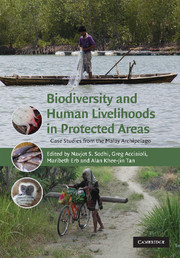Book contents
- Frontmatter
- Contents
- List of contributors
- Acknowledgements
- 1 General introduction
- Part I Conservation needs and priorities
- Part II Conservation with and against people(s)
- 11 Introduction to Part II
- 12 Collaboration, conservation, and community: a conversation between Suraya Afiff and Celia Lowe
- 13 Hands off, hands on: communities and the management of national parks in Indonesia
- 14 Conservation and conflict in Komodo National Park
- 15 Another way to live: developing a programme for local people around Tanjung Puting National Park, Central Kalimantan
- 16 For the people or for the trees? A case study of violence and conservation in Ruteng Nature Recreation Park
- 17 Seas of discontent: conflicting knowledge paradigms within Indonesia's marine environmental arena
- 18 Strategy and subjectivity in co-management of the Lore Lindu National Park (Central Sulawesi, Indonesia)
- 19 Indigenous peoples and parks in Malaysia: issues and questions
- 20 Protecting Chek Jawa: the politics of conservation and memory at the edge of a nation
- 21 Integrating conservation and community participation in protected-area development in Brunei Darussalam
- 22 Conclusion to Part II
- Part III Legal and governance frameworks for conservation
- 29 General conclusion
- Index
- References
13 - Hands off, hands on: communities and the management of national parks in Indonesia
from Part II - Conservation with and against people(s)
Published online by Cambridge University Press: 12 November 2009
- Frontmatter
- Contents
- List of contributors
- Acknowledgements
- 1 General introduction
- Part I Conservation needs and priorities
- Part II Conservation with and against people(s)
- 11 Introduction to Part II
- 12 Collaboration, conservation, and community: a conversation between Suraya Afiff and Celia Lowe
- 13 Hands off, hands on: communities and the management of national parks in Indonesia
- 14 Conservation and conflict in Komodo National Park
- 15 Another way to live: developing a programme for local people around Tanjung Puting National Park, Central Kalimantan
- 16 For the people or for the trees? A case study of violence and conservation in Ruteng Nature Recreation Park
- 17 Seas of discontent: conflicting knowledge paradigms within Indonesia's marine environmental arena
- 18 Strategy and subjectivity in co-management of the Lore Lindu National Park (Central Sulawesi, Indonesia)
- 19 Indigenous peoples and parks in Malaysia: issues and questions
- 20 Protecting Chek Jawa: the politics of conservation and memory at the edge of a nation
- 21 Integrating conservation and community participation in protected-area development in Brunei Darussalam
- 22 Conclusion to Part II
- Part III Legal and governance frameworks for conservation
- 29 General conclusion
- Index
- References
Summary
Introduction
Conservation became an important issue on the agenda in Indonesia during the 1980s, influenced by international events such as the drafting of the World Conservation Strategy in 1981 by the World Conservation Union (IUCN), the World Wide Fund for Nature (WWF), the Food and Agriculture Organization of the United Nations (FAO) and the United Nations Environment Programme (UNEP), the second international congress on National Parks in Bali and the publication of Our Common Future in 1987 (Mulyana 2002). This is not surprising considering that conservation efforts have been funded mostly by international organizations. The World Conservation Union, WWF, FAO and ADB (Asian Development Bank) have been present since the 1970s, and, more recently international organizations such as Tropenbos, The Nature Conservancy (TNC) and Conservation International (CI) have joined the crowd.
In consequence, the government intended that at least 10% of its forest area should be set aside as conservation areas. Today, conservation areas cover about 23 million ha of the 120 million or so of state forest land. All of this area was designated without any regard to existing rights of local and indigenous communities. Indeed, local communities were considered the main threat to conservation areas.
In 1999, Indonesia's government underwent some radical changes. The rigidly hierarchical and centralized government structure was transformed into a highly decentralized system, where autonomy was established at district rather than provincial level. For many local and indigenous communities these reform and decentralization processes were understood as a return of customary or adat rights.
- Type
- Chapter
- Information
- Biodiversity and Human Livelihoods in Protected AreasCase Studies from the Malay Archipelago, pp. 165 - 186Publisher: Cambridge University PressPrint publication year: 2007



